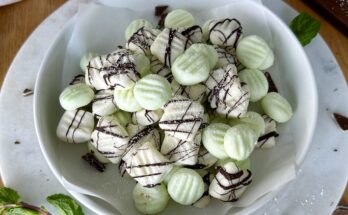Bratwurst Recipe: Bratwurst, a beloved sausage with deep roots in German cuisine, has become a favorite worldwide. Whether enjoyed at a barbecue, Oktoberfest celebration, or a casual family meal, this flavorful sausage delivers rich, savory goodness. Unlike regular sausages, bratwurst is known for its delicate balance of spices and tender texture, making it a standout on any plate.
In this guide, we’ll walk you through every step to create authentic bratwurst at home. From mixing the perfect blend of meat and spices to grilling it to perfection, you’ll learn everything you need to know. Ready to dive in? Let’s get started!
Ingredients for Bratwurst
To make bratwurst from scratch, you’ll need a carefully balanced combination of ingredients. Here’s what you’ll need:
Essential Ingredients
- Pork shoulder or pork butt (2.5 lbs): This provides the rich flavor and moisture.
- Ground veal or beef (1.5 lbs): Adds a firm texture to balance the fat content.
- Salt (2 tbsp): Essential for seasoning and binding.
- Ground white pepper (1 tsp): Adds subtle heat.
- Nutmeg (½ tsp): Enhances the savory profile.
- Mace (¼ tsp): A key spice in traditional bratwurst.
- Garlic (2 cloves, minced): For depth of flavor.
Optional Seasonings
- Marjoram (1 tsp): Common in German recipes for a mild herbal note.
- Onion powder (½ tsp): For added savoriness.
Ingredient Substitutions
- Ground chicken or turkey can be used instead of pork for a lighter option.
- If you can’t find natural casings, collagen casings work as an alternative.
Having all your ingredients prepped and ready ensures a smooth process as you move forward.
Equipment Needed
Creating bratwurst requires a few essential tools, but don’t worry—most of them are probably already in your kitchen.
Essential Kitchen Tools
- Meat grinder or food processor: For grinding the meat to the desired consistency.
- Mixing bowls: To combine the ingredients.
- Sausage stuffer: Necessary to fill the casings with the mixture.
Optional Tools
- Thermometer: To monitor internal temperature while cooking.
- Grill tongs: For easier handling on the grill.
Having these tools handy will make the entire process much more manageable.
Preparing the Sausage Mixture
The heart of any bratwurst lies in the meat blend. Follow these steps for the perfect mixture:
Step 1: Choose the Right Meat Blend
Bratwurst needs a combination of fatty and lean meats for the best texture and flavor. Aim for a 70% pork to 30% beef or veal ratio.
Step 2: Grind the Meat
- Cut the pork and beef into 1-inch chunks.
- Chill the meat and your grinder attachment for 20 minutes before grinding (this prevents smearing).
- Pass the meat through the coarse grinder plate once, then a finer plate for a smoother texture.
Step 3: Add the Spices
- Mix the ground meat with salt, pepper, nutmeg, mace, and other seasonings.
- Knead the mixture until it forms a sticky, cohesive dough. This ensures the proteins bind, giving the bratwurst a firm structure.
Once your mixture is ready, it’s time to move on to stuffing!
Stuffing the Sausages
Stuffing bratwurst is easier than you might think, especially with the right technique.
Step 1: Prepare the Casings
- Soak natural hog casings in warm water for 30 minutes.
- Rinse the inside of each casing under cool running water.
Step 2: Fill the Casings
- Attach a sausage stuffer to your grinder or use a standalone stuffer.
- Thread the casing onto the nozzle, leaving a 3-inch tail.
- Slowly push the meat mixture through the stuffer, guiding the casing with your hand. Avoid overstuffing to prevent splitting.
Step 3: Form Links
- Once stuffed, twist the casing at regular intervals to form individual sausages.
- Tie off the ends with butcher’s twine if necessary.
Take your time here—getting evenly stuffed sausages makes all the difference!
Cooking Methods for Bratwurst
Now that your bratwursts are ready, it’s time to cook them. There are multiple methods you can choose from based on your preferences:
- Grilling: A popular option that adds a smoky, charred flavor.
- Pan-Frying: Perfect for a crispy, golden-brown crust.
- Simmering in Beer: Enhances the sausage’s flavor with aromatic notes.
Each method has its own set of steps and best practices. We’ll cover grilling first, as it’s a crowd favorite.
Grilling Bratwurst to Perfection
Grilling is one of the best ways to cook bratwurst, especially when you’re looking for that signature smoky flavor and grill marks. Here’s how to master it:
Step 1: Preheat the Grill
- Set your grill to medium heat (around 350°F to 400°F).
- Allow the grill to preheat for about 10 minutes. If using charcoal, ensure the coals have a light gray ash coating before starting.
Step 2: Prepare the Bratwurst
- Lightly brush the bratwurst with oil to prevent sticking.
- Avoid poking holes in the sausage, as this will cause juices to escape and result in dry bratwurst.
Step 3: Grill the Bratwurst
- Place the bratwurst on the grill over indirect heat.
- Cook for about 15–20 minutes, turning every 4–5 minutes to ensure even cooking. Move them over direct heat for the last 2–3 minutes to achieve a caramelized, golden crust.
- Check the internal temperature with a meat thermometer—it should reach 160°F.
By following these steps, you’ll get perfectly juicy bratwurst every time.
Pan-Frying Bratwurst
Pan-frying is a convenient method that’s ideal when grilling isn’t an option. Here’s how to achieve crispy, browned bratwurst with a juicy interior:
Step 1: Heat the Pan
- Use a heavy skillet, such as cast iron, to ensure even heat distribution.
- Add a tablespoon of oil or butter and heat over medium heat until it shimmers.
Step 2: Cook the Bratwurst
- Place the bratwurst in the pan, leaving some space between each sausage.
- Sear them on one side for 4–5 minutes until golden brown. Turn the sausages and sear the other side.
Step 3: Finish Cooking
- Reduce the heat to low and cover the pan with a lid.
- Cook for another 10 minutes, turning occasionally, until the internal temperature reaches 160°F.
This method locks in the bratwurst’s juices while giving it a delicious, crispy exterior.
Simmering Bratwurst in Beer
Simmering bratwurst in beer before or after grilling is a popular technique that adds extra flavor and tenderness.
Step 1: Choose Your Beer
- Use a mild, flavorful beer such as a lager or pilsner. Avoid beers that are too dark or bitter, as they can overpower the bratwurst’s natural flavors.
Step 2: Prepare the Beer Bath
- In a large pot, add 2–3 cans of beer along with sliced onions, garlic, and a few herbs (such as thyme or bay leaves).
- Bring the mixture to a simmer over medium heat.
Step 3: Simmer the Bratwurst
- Place the bratwurst in the beer bath and simmer gently for 10–15 minutes.
- Avoid boiling, as high heat can cause the casings to burst.
- After simmering, finish the sausages by grilling or pan-frying for a golden crust.
This technique infuses the bratwurst with rich, aromatic flavors that elevate the dish.
Serving Suggestions
A perfectly cooked bratwurst deserves equally delicious sides and toppings. Here are some ideas to enhance your meal:
Traditional Accompaniments
- Sauerkraut: The tangy, fermented cabbage adds a perfect contrast to the savory bratwurst.
- German potato salad: Made with vinegar and bacon, this warm salad complements the rich flavors of the sausage.
- Soft pretzels: A classic pairing, especially for Oktoberfest celebrations.
Creative Sides and Toppings
- Caramelized onions: Sweet, tender onions add a burst of flavor.
- Beer cheese sauce: A creamy, cheesy sauce with hints of beer pairs beautifully with bratwurst.
- Coleslaw: For a fresh, crunchy contrast to the sausage.
Experiment with different combinations to find your perfect pairing.
Homemade Mustard and Sauces
While store-bought mustard works fine, making your own mustard or other condiments can take your bratwurst to the next level.
Quick Mustard Sauce Recipe
- Ingredients:
- 2 tablespoons Dijon mustard
- 1 tablespoon whole-grain mustard
- 1 tablespoon honey
- 1 tablespoon apple cider vinegar
- Instructions:
- Whisk all ingredients together in a small bowl. Adjust sweetness or acidity to taste.
Other Condiment Ideas
- Spicy ketchup: Add a pinch of cayenne to ketchup for a kick.
- Herbed aioli: A blend of garlic, mayo, and fresh herbs adds a creamy touch.
These homemade sauces elevate the bratwurst’s flavor profile and impress your guests.
Pairing Bratwurst with Drinks
Pairing your bratwurst with the right drink enhances the entire dining experience. Here’s what to consider:
Beer Pairings
- Lager: Light and crisp, it complements the savory spices in the bratwurst.
- Weissbier (wheat beer): A traditional pairing that brings out the sausage’s richness.
Wine Options
- Riesling: Its bright acidity cuts through the fat and balances the flavors.
- Pinot Noir: A light red wine with earthy undertones that pairs well with grilled bratwurst.
For non-alcoholic options, consider sparkling water with lemon or a refreshing ginger ale.
Common Mistakes and Troubleshooting
Even seasoned cooks can run into a few hiccups. Here’s how to avoid common mistakes:
Mistake #1: Overstuffing the Casings
- Overstuffing can lead to burst sausages during cooking. Leave some slack when stuffing to prevent this issue.
Mistake #2: Cooking Over High Heat
- High heat can cause bratwurst to split and lose moisture. Always use medium heat for a slower, even cook.
Mistake #3: Skipping the Rest Period
- Letting the bratwurst rest for a few minutes after cooking helps retain juices.
By keeping these tips in mind, you’ll achieve better results with each batch.
Storage and Leftover Tips
If you’ve got leftover bratwurst, here’s how to store and enjoy them later:
Storage
- Refrigeration: Store cooked bratwurst in an airtight container for up to 3 days.
- Freezing: Wrap the sausages tightly in plastic wrap and place them in a freezer bag. They can be frozen for up to 3 months.
Reheating
- Reheat in a skillet over low heat to prevent drying out. You can also simmer them in beer or broth for added moisture.
Creative Leftover Ideas
- Slice bratwurst and add it to pasta, stir-fries, or breakfast hash.
- Use it as a topping for pizza or flatbreads.
These tips will help you reduce waste and enjoy every last bite of your bratwurst.
FAQs about Bratwurst Recipe
1. What ingredients are needed for a basic bratwurst recipe?
To make bratwurst at home, you’ll need ground pork or a mix of pork and veal, spices like salt, pepper, marjoram, and nutmeg, and natural sausage casings. You can also add garlic or onion powder for extra flavor.
2. How long should bratwurst be cooked?
Bratwurst should be cooked until it reaches an internal temperature of 160°F. This typically takes about 15 to 20 minutes on a grill or stovetop. Be sure to turn them frequently for even cooking.
3. Can bratwurst be cooked in a pan?
Yes, cooking bratwurst in a pan is a popular method. Simply heat a little oil over medium heat and cook the bratwurst for about 10 minutes, turning occasionally until they are evenly browned and cooked through.
4. Is it necessary to boil bratwurst before grilling?
While not necessary, boiling bratwurst before grilling can ensure they cook evenly and reduce grilling time. Simmer the sausages in water or beer for about 10 minutes before finishing them on the grill.
5. What are some traditional side dishes to serve with bratwurst?
Traditional sides include sauerkraut, potato salad, and mustard. For a hearty meal, you might also serve bratwurst with pretzels or roasted vegetables.
6. How can I make my bratwurst juicy and flavorful?
To keep bratwurst juicy, avoid overcooking and consider simmering them in beer before grilling. Season well with your choice of spices and herbs to enhance the natural flavors of the meat.
7. Can bratwurst be frozen after cooking?
Yes, cooked bratwurst can be frozen for up to three months. Cool them completely before freezing and wrap tightly to minimize exposure to air. Thaw in the refrigerator before reheating.
Conclusion
Making bratwurst at home might seem intimidating at first, but with the right steps and techniques, it’s easier than you think! From grinding and stuffing to grilling and serving, each step adds to the final flavor experience. Try different variations, experiment with sides, and have fun mastering this timeless recipe. You’ll be the star of your next cookout!



